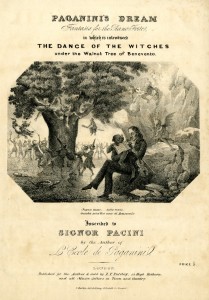Music is a subject often mentioned in Francis Douce’s correspondence. He was a keen amateur, interested in both contemporary music and the technical development of musical instruments throughout the centuries. A vast amount of images of different types of drums, lutes, harps, horns, trumpets, pipes, violins, etc. can be found in his portfolios.
On 7 December 1832, Douce wrote to George Cumberland about a peculiar musical night out:
Tricks are certainly not musick & the many now played to delight stupid audiences, keep me from musick exhibitions; but I certainly did go twice, for the first time I was almost suffocated & could hear little, to hear that wonderful fellow Paganini, whose person & gesticulations amused me even more than his performance. His Benevento witchcraft musick has something supernatural.
Le Streghe, or ‘Witches’ Dance’, was the ‘witchcraft music’ to which Douce refers in his letter. It was inspired by a piece of Italian lore concerning the annual convocation of witches around the walnut tree of Benevento, in Naples. A music song-sheet published in London in the early 1830s shows Paganini sitting under the tree surrounded by witches and demons:
According to contemporary reviews, Douce’s reaction to Paganini’s performance was not unusual: an article on the musician published in the Court Magazine and Belle Assemblée in October of the same year focused on his ‘witchery’ and described him as ‘an incarnation of one of those wild and unaccountable fantasies engendered only in highly-excited imaginations’.
Apart from the music itself, the subject of Paganini’s piece may have had a special appeal for Douce, who collected a large number of prints and drawings depicting witches, demons and goblins. More intriguingly, in 1826 he chose what he described as ‘an old picture [exhibiting] a long forgotten superstitious practice of a diabolical nature’ to decorate one of the bedrooms of his home.

